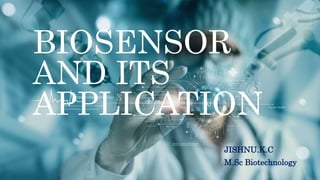This document discusses biosensors, which are analytical devices that use biological materials to measure analyte concentration through interactions that are converted into electrical signals. It details the components, working principles, and various types of biosensors, including electrochemical, optical, and piezoelectric sensors, along with their applications in medical diagnostics, environmental monitoring, and food safety. Key features of biosensors such as sensitivity, specificity, and response time are also emphasized.















































